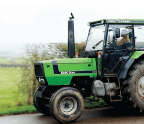Going green

Back in the 1950s and early ’60s, hay was the main crop used by European farmers to feed their cattle during the winter months. The art of making good-quality hay was very dependent on the weather. Large-scale silage making was still in its infancy and the process was a relatively new way to make winter fodder for many farmers.
Hay provided reasonable feeding value for cattle. Agricultural research studies indicated that good-quality silage had a higher feed value than hay. Beef cattle feed with silage had improved growth and weight gains. In the dairy sector the improvement was even more significant. Cows fed silage during the winter months, when housed inside, showed a marked improvement in milk production.
Ministry of Agriculture grants in the UK became available to farmers to build silos/clamps and invest in agricultural machinery. More efficient food production was the order of the day in post-war Britain and this encouraged farmers that silage making was the way forward in progressive agriculture.
Silage making in the early years involved grass being cut with fingerbar mowers. Tractors with large-tine buckrakes, attached to a front-mounted loader or the three-point linkage, were driven or reversed up the sward of grass until a full load was achieved. This grass was then taken to the clamp or silo on the buckrake.
Another way to lift silage was with a green crop loader. This was ground driven and picked up the sward of grass using an elevator system of chains and tines to deposit the grass on the trailer.
Farmers were looking for a more efficient method to harvest grass to make silage. This technology became available following development in the United States. Farmers in
You’re reading a preview, subscribe to read more.
Start your free 30 days



